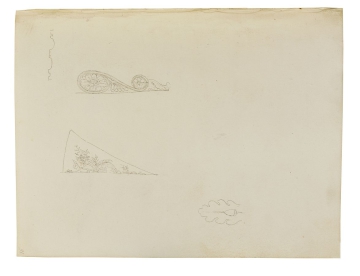
Browse
Reference number
Purpose
Aspect
Scale
Hand
Notes
The cornucopia is a large horn overflowing with fruits. It is the horn of plenty. It has many associations and accompanies various allegorical figures. Most notably for the Bank, perhaps, is its association with Fortune. The cornucopia of Fortune features on Renaissance medals that commemorate public celebrations (Hall, p.75). During the 17th and 18th centuries the cornucopia was combined with the caduceus, as in this drawing, in commercial buildings and banks to signify prosperity (Lewis and Darley, p. 93).
In Roman society, the oak leaf was bound into wreaths that recognized civic virtue. In Renaissance and Neo-classical decoration, the wreaths are often scattered with acorns (Lewis and Darley, p.217).
Literature
J. Hall, Subjects & Symbols in Art, 1992
Level
Sir John Soane's collection includes some 30,000 architectural, design and topographical drawings which is a very important resource for scholars worldwide. His was the first architect’s collection to attempt to preserve the best in design for the architectural profession in the future, and it did so by assembling as exemplars surviving drawings by great Renaissance masters and by the leading architects in Britain in the 17th and 18th centuries and his near contemporaries such as Sir William Chambers, Robert Adam and George Dance the Younger. These drawings sit side by side with 9,000 drawings in Soane’s own hand or those of the pupils in his office, covering his early work as a student, his time in Italy and the drawings produced in the course of his architectural practice from 1780 until the 1830s.
Browse (via the vertical menu to the left) and search results for Drawings include a mixture of Concise catalogue records – drawn from an outline list of the collection – and fuller records where drawings have been catalogued in more detail (an ongoing process).

